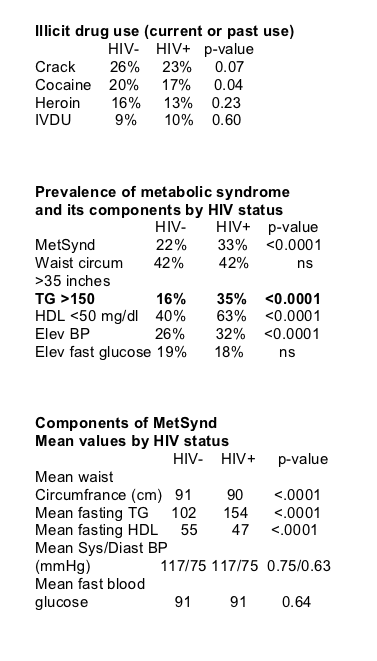 |
 |
 |
| |
HIV+ Women in WIHS: 33% have Metabolic Syndrome
|
| |
| |
- Nevirapine associated with lower risk for Metabolic Syndrome
- lipids associated with metabolic syndrome but not ritonavir boosted protease inhibitor
- higher HIV viral load associated with risk for metabolic syndrome (suggesting that HAART reduces risk for cardiovascular disease)
- white and Hispanic ethnicity associated with higher risk for metabolic syndrome compared to Blacks, but BMI is associated with greater risk for metabolic syndrome
"Prevalence and predictors of Metabolic Syndrome among HIV+ and Negative Women in the Women's Interagency HIV Study"
Reported by Jules Levin
XVI Intl AIDS Conference, Toronto Aug 16, 2005
MS Sobieszcyk1, D Hoover2, K Anastos3, K Mulligan4, T Tan5, Q Shi6, C Hyman7, M Cohen8, SR Cole9, J Justman,10, and Women's Interagency HIV Study
1Columbia University, NY, NY, 2Rutgers University, NJ, 3 Montefiore Medical Center and Lincoln med and Mental health Center, Bronx, NY, 4University of Cal, SF, CA, 5 Data Solutions, LLC, Bronx, NY, 6 New York Medical College, Va;hala, NY, 7 Kings County Hospital Center, Brookly, NY, 8 Cook County Hospital, Chi, Ill, 9 Johns Hopkins Bloomberg Sch of Public Heath, Balt, MD, 10Mailman Sch of Pub Health, Columbia University, NY, NY
AUTHOR CONCLUSIONS:
Metabolic syndrome is more prevalent in HIV+ than HIV- women due primarily to lipids rather than other factors. Among HIV- women the traditional risk factors of BMI, smoking, age, and parity were associated with metabolic syndrome, while whit race/ethnicity was not. Among HIV+ women, white race and Hispanic ethnicity, higher CD4 count, higher HIV-1 RNA and d4T use were significantly associated with metabolic syndrome in a multivariate model. Nevirapine and light to moderate alcohol use were significantly associated with lower prevalence of MetSynd. In the multivariate models, ritonavir boosted PI use was not significantly associated with the metabolic syndrome.
Background provided by authors.
The prevalence of Metabolic Syndrome (MetSynd) has been well described in the general population and has been rising particularly among women. This constellation of metabolic disturbances is frequently associated with increased risk of cardiovascular morbidity and mortality in the general population. There are limited data, however, about the prevalence of MetSynd among HIV+ persons, but it appears to be higher than in the general population. Few studies have been performed to evaluate risk and prevalence of MetSynd in the growing population of HIV+ women.
The prevalence for MetSynd was assessed among HIV+ and negative women in the Women's Ineragency HIV Study (WIHS) seen from October 2000 to October 2004.
RESULTS
Of the 668 HIV+ and 1726 HIV uninfected women who provided fasting samples at one visit, MetSynd was more prevalent among HIV+ (33%) than HIV-negative (22%) women (p<0.0001). In the HIV+ compared to HIV- women, mean trygliceride level was higher (154 mg/dl vs 102 mg/dl), p<0.0001) and mean HDL cholesterol was lower (47 mg/dl vs 55 mg/dl, p<0.0001). No difference was observed in mean fasting glucose or blood pressure (see tables below). Increased triglycerides and low HDL were the most common components present among those with MetSynd for both HIV+ and negative women. 32% and 29% of HIV+ women were on PI-based and non-PI based HAART, respectively.
In multivariate analysis restricted to HIV+ women, factors significantly associated with MetSynd were: older age (OR=1.42 per 5 years, p<0.0001), White (OR=1.90. p<0.001), or Hispanic (OR=1.50, p<0.001) compared to Black race/ethnicity; higher BMI (OR=3.27 and 9.15, for BMI 26-30 and >30 kg/m2 respectively, (p<0.001 for both); current smoking (OR=1.29, p<0.05) and use of d4T (OR=1.29, p<0.05). There was a trend to higher prevalence of MetSynd in women with a CD4 count >350 cell/ul (OR=1.20, p=0.05), or with higher HIV-1 RNA (OR=1.20, p=0.05, and OR=1.36, p<0.05, for HIV- RNA 10,001-50,000 and >50,000, respectively). Among the HIV-negative women, BMI, age, parity and smoking status were associated with MetSynd.
Conclusions
MetSynd is more prevalent in the HIV+ than HIV-negative women. Increased MetSynd is associated with older age and other traditional risk factors in both groups. For HIV+ women higher HIV RNA levels and use of d4T were associated with an increased prevalence of MetSynd.
Study Population. WIHS is a prospective, multicenter cohort study of HIV+ and high-risk HIV- women in 6 inner city sites across the USA. This was a cross-sectional study and the main outcome was prevalence of metabolic syndrome at a visit. The recently updated NCEP Adult Treatment Panel III (ATP III) definition was used to identify participants with the metabolic syndrome. According to this definition, participants who had 3 or more of the following criteria were defined as having metabolic syndrome: (1) waist measurement 35 inches (88 cm or more) or more for women, (2) hypertrygliceridemia of 150 mg/dl or higher or drug treatment for elevated tryglicerides; (3) reduced HDL cholesterol of less than 50 mg/dl or drug treatment for reduced HDL-C; (4) elevated blood pressure (systolic 130 mmHg or more or diastolic of 85 mmHg or more using the average of 2 seayed measurements) or antihypertensive drug treatment in a patient with a history of hypertension; (5) elevated blood glucose of 100 or more mg/dl or currently usinf antidiabetic medication.
Ethnicity: there was no difference between the groups with 28% Hispanic, 59% African-American, 11% White, and 4% other. 18% of HIV- and 29% of HIV+ women were HCV Ab positive. Mean CD4 count was 428. Mean HIV-1 RNA was 3.1 log copies/ml. 18% were ART-naive; 34% were not on ART; 32% were on a PI regimen; 29% were on a PI-sparing regimen. 15% were on EFV regimen. 24% were on d4T. 14% were on NVP. 8% were on a RTV boosted regimen.

|
| |
|
 |
 |
|
|